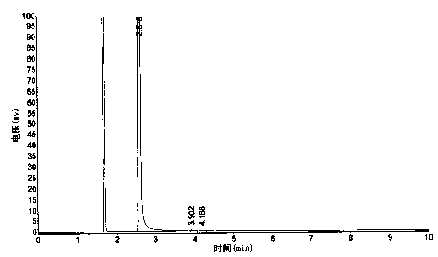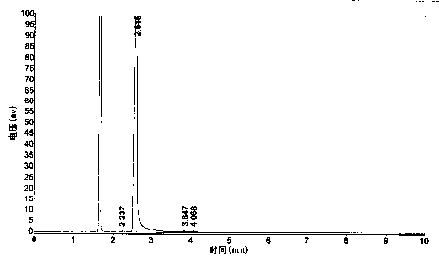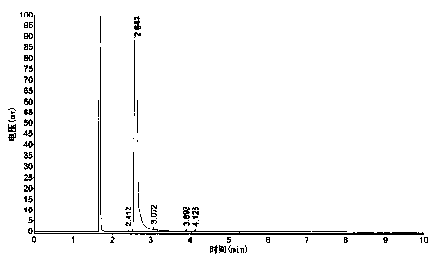A method for detecting the purity of 3-methylamino-1,2-propanediol by gas chromatography
A technology of gas chromatography and detection method, which is applied in the field of separation of various impurity components in 3-methylamino-1,2-propanediol, and can solve the problems of difficult data accuracy, complicated post-processing steps, and large amount of n-hexane and other problems, to achieve the effect of simple operation, saving analysis time and high recovery rate
- Summary
- Abstract
- Description
- Claims
- Application Information
AI Technical Summary
Problems solved by technology
Method used
Image
Examples
Embodiment 1
[0061] Example 1 Solvent Screening Test
[0062] Due to the high viscosity of 3-methylamino-1,2-propanediol, the impurities in 3-methylamino-1,2-propanediol cannot be separated by direct injection, so solvent dilution was considered to reduce the viscosity of the injection.
[0063] The applicant selected ethanol, acetone, trichloroethane, n-hexane, etc. to dissolve 3-methylamino-1,2-propanediol, and carried out analysis experiments under the same detection conditions.
[0064] When acetone is used, acetone reacts rapidly with 3-methylamino-1,2-propanediol, and the sample gradually changes from colorless to light yellow in a short period of time, and the peaks of each component in the detection spectrum overlap and are difficult to separate;
[0065] Using ethanol and trichloroethane, although the separation effect of the main component 3-methylamino-1,2-propanediol is better, either low boilers (refers to boiling points lower than 3-methylamino-1,2-propanediol) Components) c...
Embodiment 2
[0068] Embodiment 2 A method for detecting the purity of 3-methylamino-1,2-propanediol by gas chromatography
[0069] Include the following steps:
[0070] 1. Sample preparation
[0071] Dissolve about 0.1 mL of 3-methylamino-1,2-propanediol in 2 mL of chromatographically pure methanol, fully dissolve and set aside.
[0072] 2. Setting of chromatographic conditions
[0073] (1) Chromatograph (FL9790 produced in Wenling, Zhejiang);
[0074] (2) Detector (FID), hydrogen flame ionization detector;
[0075] (3) Agilent gas chromatography column, DB-1701 (30m×0.32mm×0.5um) quartz capillary column;
[0076] (4) Column temperature, 240°C; injection volume 0.2µL, split injection, split ratio 20:1; carrier gas nitrogen, flow rate 40mL / min; air flow rate 450 mL / min; hydrogen 45mL / min;
[0077] (5) Temperature of vaporization chamber, 280°C;
[0078] (6) Detector temperature, 280°C.
[0079] 3. Detection operation
[0080] Turn on the power of the chromatograph and turn it on. Be...
Embodiment 3
[0091] Embodiment 3 A method for detecting the purity of 3-methylamino-1,2-propanediol by gas chromatography
[0092] Control: On the basis of the method in Example 2, only the column temperature was changed, the temperature of the vaporization chamber was not changed, and the column temperature was only raised to 260°C. The experimental result: the low boilers before the main peak came out, but the peak was not obvious , the separation effect is very poor; there should be three peaks after the main peak, but there are only two peaks.
[0093] The reason for the analysis is that the temperature of the vaporization chamber is low. According to the general law of gas chromatographic analysis, the temperature of the injection port should be higher than the boiling point of the analyte to ensure that all analytes can be completely vaporized after being injected through the injection port. The inlet temperature is a prerequisite for GC analysis. If the temperature is too high, the...
PUM
 Login to View More
Login to View More Abstract
Description
Claims
Application Information
 Login to View More
Login to View More - R&D
- Intellectual Property
- Life Sciences
- Materials
- Tech Scout
- Unparalleled Data Quality
- Higher Quality Content
- 60% Fewer Hallucinations
Browse by: Latest US Patents, China's latest patents, Technical Efficacy Thesaurus, Application Domain, Technology Topic, Popular Technical Reports.
© 2025 PatSnap. All rights reserved.Legal|Privacy policy|Modern Slavery Act Transparency Statement|Sitemap|About US| Contact US: help@patsnap.com



